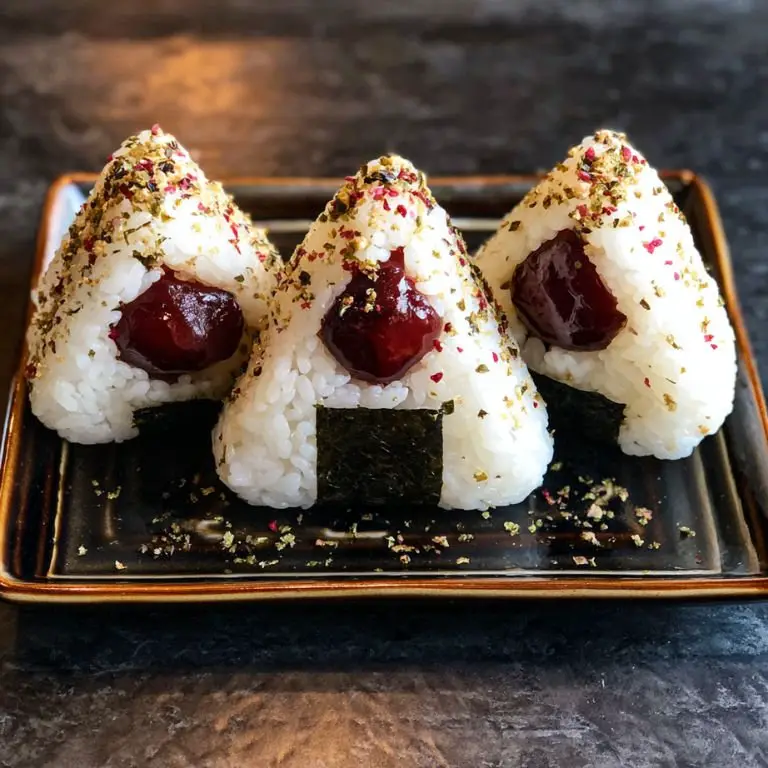There’s something incredibly satisfying about making and eating onigiri—the humble Japanese rice ball that packs a punch of flavor in a small, hand-held bundle. This vegan umeboshi onigiri recipe features a classic pickled plum center that’s equal parts tangy, salty, and savory. It’s one of those easy onigiri recipes that you can whip up with just a few ingredients, yet it delivers bold, nostalgic flavors that transport you straight to a Japanese train station bento shop. Whether you’re a fan of vegan sushi, scouting new onigiri recipe filling ideas, or just looking to diversify your homemade onigiri lunch options, this recipe is a plant-based winner.
Vegan Umeboshi Onigiri with Pickled Plum Center
Prep Time 15 minutes mins
Cook Time 25 minutes mins
Total Time 40 minutes mins
Course Side Dish, Snack
Cuisine Japanese
Servings 4 (makes about 6 medium onigiri)
Rice cooker or medium saucepan with lid for perfectly steamed rice
Rice paddle or spatula helps handle the sticky rice without crushing it
Bowl of water with a pinch of salt to keep your hands wet and prevent sticking while shaping the onigiri
Clean kitchen towel or plastic wrap to help shape the rice if you're new to onigiri
For the Rice
- 2 cups Japanese short-grain white rice sushi rice
- 2 ½ cups water
- ½ teaspoon salt or to taste
For the Filling
- 4 –6 whole umeboshi Japanese pickled plums, pits removed
Optional for Wrapping
- 4 –6 sheets of nori seaweed, cut into strips or squares
Optional Seasonings
- Toasted sesame seeds
- Furikake ensure it's a vegan version, without bonito flakes
- Shiso leaf if available, adds a fresh herbal note
Cook the Rice
Start by rinsing your rice thoroughly in cold water until the water runs mostly clear. This removes excess starch and helps achieve that perfect sticky texture without becoming mushy.
Transfer the rinsed rice into your rice cooker or saucepan. Add water and cook according to your device’s instructions. If cooking on the stovetop, bring to a boil, reduce to a simmer, cover, and cook for 15–18 minutes. Let it rest off heat for 10 minutes after cooking.
Prepare the Filling
While the rice is resting, remove the pits from your umeboshi. These intensely sour-salty plums are what give umeboshi onigiri its unique identity. You can mash them slightly or keep them whole depending on your texture preference.
Season and Cool the Rice
Once the rice is cooked, fluff it gently with a rice paddle and let it cool slightly until it's warm but not scalding to touch. You can sprinkle a bit of salt over the rice for extra flavor, but note that the umeboshi are already quite salty.
Shape the Onigiri
Set up your workstation: a small bowl of salted water, your nori strips, and a plate for your finished onigiri.
Wet your hands with the salted water and grab about ⅓ to ½ cup of rice. Flatten slightly into a disk in your palm.
Place a bit of mashed umeboshi or a whole pitted plum in the center. Fold the rice around the filling and gently form it into a triangle or oval shape, using your fingers to mold but not over-pack.
Optional: wrap a strip of nori around the base or back of the onigiri to make it easier to hold and add that classic umami seaweed flavor.
Garnish and Serve
Sprinkle with toasted sesame seeds or vegan furikake if desired. You can also tuck in a bit of shiso leaf for an extra layer of flavor.
Pairings
These umeboshi onigiri are incredibly versatile and can be paired in various ways depending on the occasion.
- With Soup: A bowl of miso soup or a warm, brothy fall crockpot recipe like vegan miso vegetable stew makes an excellent pairing.
- In a Bento: For a full onigiri bento, pack your rice balls with pickled vegetables, edamame, tamagoyaki (use tofu scramble for a vegan version), and a couple of seasonal fruits.
- For a Picnic: These travel beautifully and are great for a homemade onigiri lunch outdoors, especially during spring hanami or fall leaf-viewing.
If you’re celebrating New Year’s Eve or Day and looking for unique nye food options, onigiri makes an elegant, handheld bite that’s filling without being heavy—especially when many guests appreciate vegetarian or vegan options.
FAQs
1. Can I use brown rice instead of white rice?
Yes, you can, but be aware that brown rice doesn’t have the same sticky texture as short-grain white rice. If using brown rice, opt for short-grain varieties and be prepared for a less cohesive onigiri.
2. What kind of umeboshi should I use?
Look for whole umeboshi in jars or vacuum-sealed packs at Asian grocery stores. Some are more sour than others—if it’s your first time, try a milder version or use a smaller amount per rice ball.
3. Can I use other fillings besides umeboshi?
Absolutely! If you're exploring onigiri recipe filling ideas, try sautéed mushrooms, miso-marinated tofu, or avocado with soy sauce. For vegetarian onigiri or vegan sushi variations, the possibilities are endless.
4. How do I keep onigiri fresh?
Onigiri is best eaten the day it's made, but you can wrap them tightly in plastic wrap and store in an airtight container for up to a day at room temperature. Avoid refrigerating if possible, as the rice hardens.
5. Can I make these into onigirazu?
Yes! Onigirazu is like a larger, sandwich-style rice ball wrapped in nori. Just flatten the rice, place your umeboshi and any other fillings in the center, and fold the rice and nori around it like a parcel. Great for those who love sushi recipes homemade but want more room for fillings.
